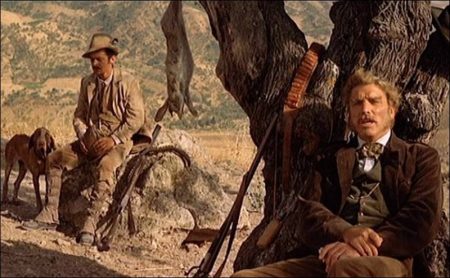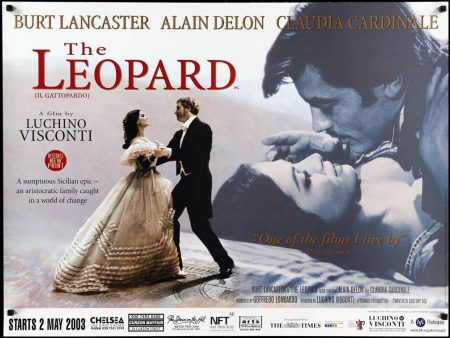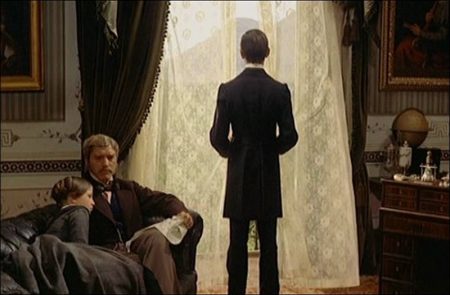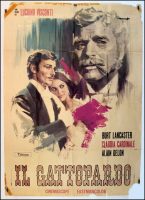The Leopard movie storyline. In the 1860s, a dying aristocracy struggles to maintain itself against a harsh Sicilian landscape. The film traces with a slow and deliberate rhythm the waning of the noble home of Fabrizio Corbero, Prince of Salina (the Leopard) and the corresponding rise to eminence of the enormously wealthy ex-peasant Don Calogero Sedara.
The prince himself refuses to take active steps to halt the decline of his personal fortunes or to help build a new Sicily but his nephew Tancredi, Prince of Falconeri swims with the tide and assures his own position by marrying Don Calogero’s beautiful daughter Angelica. The climatic scene is the sumptuous forty-minute ball, where Tancredi introduces Angelica to society.
The Leopard (Italian: Il Gattopardo, “The Serval” is a 1963 Italian epic period drama film by director Luchino Visconti, based on Giuseppe Tomasi di Lampedusa’s 1958 novel of the same title. The film features an international cast including the American Burt Lancaster, the Frenchman Alain Delon, the Italian Claudia Cardinale (who is dubbed in the Italian version by Solvejg D’Assunta because her native tongue was Sicilian and French) and Terence Hill (Mario Girotti). In the Italian-language 185 minutes version, Lancaster’s lines are dubbed into Italian by Corrado Gaipa; while in the 161-minute U.S English dubbed version, Lancaster’s original voice work is heard.
About the Story
In Sicily in 1860, Don Fabrizio Corbera, Prince of Salina enjoys the customary comforts and privileges of an ancient and noble name. War has broken out between the armies of Francis II of the Two Sicilies and the insurgent volunteer redshirts of Giuseppe Garibaldi. Among the rebels is the Prince’s remarkably handsome and dashing nephew, Tancredi, with whose romantic politics the Prince shares some whimsical sympathy. Moved by the uprising, the Prince departs for nearby Palermo. Garibaldi’s army conquers the city and Sicily from the Bourbons. The Prince muses upon the inevitability of change, with the middle class displacing the hereditary ruling class while on the surface everything remains the same.
Refusing to bend to the tide of necessity, the Prince departs for his summer palace at Donnafugata. A new national assembly has called a plebiscite which the nationalists win 512-0, thanks to the corruption of the town’s leading citizen, Don Calogero Sedara, who sees his daughter, the exquisitely beautiful Angelica, as a ticket of admittance to the high-class soirées of the nobility. Bringing her with him to the villa of the Salinas, he watches as both the Prince and Tancredi fall abjectly in love with her. Realising his chance, he effectively pimps his daughter to the aristocracy, and Tancredi offers his hand.
The Prince sees the wisdom of the match because he knows his nephew’s vaulting ambition and need for ready cash, which Angelica’s father, greedy for familial prestige, will happily make available. With the mutual blessing of the Prince of Salina and Don Calogero, Tancredi and Angelica become engaged.
A visitor from the constituent assembly comes to the villa. He begs the great scholar and nobleman to join the senate and help direct the ship of state; he hopes that the Prince’s great compassion and wisdom will help alleviate the poverty and ignorance to be seen everywhere on the streets of Sicily. However, the Prince demurs and refuses this invitation, claiming that Sicily prefers its sleep to the agitations of modernity because its people are proud of who they are. He sees a future when the leopards and the lions, along with the sheep and the jackals, will all live according to the same law, but he does not want to be a part of this democratic vision.
He notes that Tancredi has shifted allegiances from the insurgent Garibaldi to the king’s army, and wistfully recognises that his nephew is the kind of opportunist and time-server who will flourish in the new Italy. A great ball is held at the villa of a neighboring Prince, and the Salinas and Tancredi attend.
Afflicted by a combination of melancholia, the ridiculousness of the nouveau riche, and age, the Prince wanders forlornly from chamber to chamber, increasingly disaffected by the entire edifice of the society he so gallantly represents – until Angelica approaches and asks him to dance. Stirred and momentarily released from his cares, the Prince accepts, and once more he resembles the elegant and dashing figure of his past.
The Leopard (1963)
Directed by: Luchino Visconti
Starring: Burt Lancaster, Claudia Cardinale, Alain Delon, Serge Reggiani, Mario Girotti, Pierre Clementi, Giuliano Gemma, Ottavia Piccolo, Romolo Valli, Anna Maria Bottini
Screenplay by: Pasquale Festa Campanile, Enrico Medioli, Massimo Franciosa, Luchino Visconti, Suso Cecchi d’Amico
Production Design by: Mario Garbuglia
Cinematography by: Giuseppe Rotunno
Film Editing by: Mario Serandrei
Costume Design by: Piero Tosi
Set Decoration by: Laudomia Hercolani, Giorgio Pes
Music by: Nino Rota
MPAA Rating: None.
Distributed by: Titanus (Italy), 20th Century Fox (USA)
Release Date: March 27, 1963 (Italy), August 12, 1963 (USA)
Views: 210




